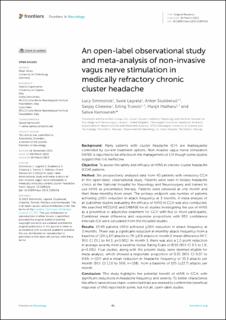| dc.contributor.author | Simmonds, Lucy | |
| dc.contributor.author | Lagrata, Susie | |
| dc.contributor.author | Stubberud, Anker | |
| dc.contributor.author | Cheema, Sanjay | |
| dc.contributor.author | Tronvik, Erling Andreas | |
| dc.contributor.author | Matharu, Manjit | |
| dc.contributor.author | Kamourieh, Salwa | |
| dc.date.accessioned | 2023-10-26T09:15:13Z | |
| dc.date.available | 2023-10-26T09:15:13Z | |
| dc.date.created | 2023-05-15T10:34:12Z | |
| dc.date.issued | 2023 | |
| dc.identifier.citation | Frontiers in Neurology. 2023, 14 . | en_US |
| dc.identifier.issn | 1664-2295 | |
| dc.identifier.uri | https://hdl.handle.net/11250/3098880 | |
| dc.description.abstract | Background: Many patients with cluster headache (CH) are inadequately controlled by current treatment options. Non-invasive vagus nerve stimulation (nVNS) is reported to be effective in the management of CH though some studies suggest that it is ineffective.
Objective: To assess the safety and efficacy of nVNS in chronic cluster headache (CCH) patients.
Method: We prospectively analysed data from 40 patients with refractory CCH in this open-label, observational study. Patients were seen in tertiary headache clinics at the National Hospital for Neurology and Neurosurgery and trained to use nVNS as preventative therapy. Patients were reivewed at one month and then three-monthly from onset. The primary endpoint was number of patients achieving ≥50% reduction in attack frequency at 3 months. A meta-analysis of all published studies evaluating the efficacy of nVNS in CCH was also conducted. We searched MEDLINE and EMBASE for all studies investigating the use of nVNS as a preventive or adjunctive treatment for CCH with five or more participants. Combined mean difference and responder proportions with 95% confidence intervals (CI) were calculated from the included studies.
Results: 17/40 patients (43%) achieved ≥50% reduction in attack frequency at 3 months. There was a significant reduction in monthly attack frequency from a baseline of 124 (±67) attacks to 79 (±63) attacks in month 3 (mean difference 44.7; 95% CI 25.1 to 64.3; p < 0.001). In month 3, there was also a 1.2-point reduction in average severity from a baseline Verbal Rating Scale of 8/10 (95% CI 0.5 to 1.9; p = 0.001). Four studies, along with the present study, were deemed eligible for meta-analysis, which showed a responder proportion of 0.35 (95% CI 0.07 to 0.69, n = 137) and a mean reduction in headache frequency of 35.3 attacks per month (95% CI 11.0 to 59.6, n = 108), from a baseline of 105 (±22.7) attacks per month.
Conclusion: This study highlights the potential benefit of nVNS in CCH, with significant reductions in headache frequency and severity. To better characterise the effect, randomised sham-controlled trials are needed to confirm the beneficial response of VNS reported in some, but not all, open-label studies. | en_US |
| dc.language.iso | eng | en_US |
| dc.publisher | Frontiers Media | en_US |
| dc.rights | Navngivelse 4.0 Internasjonal | * |
| dc.rights.uri | http://creativecommons.org/licenses/by/4.0/deed.no | * |
| dc.title | An open-label observational study and meta-analysis of non-invasive vagus nerve stimulation in medically refractory chronic cluster headache | en_US |
| dc.title.alternative | An open-label observational study and meta-analysis of non-invasive vagus nerve stimulation in medically refractory chronic cluster headache | en_US |
| dc.type | Peer reviewed | en_US |
| dc.type | Journal article | en_US |
| dc.description.version | publishedVersion | en_US |
| dc.source.pagenumber | 0 | en_US |
| dc.source.volume | 14 | en_US |
| dc.source.journal | Frontiers in Neurology | en_US |
| dc.identifier.doi | 10.3389/fneur.2023.1100426 | |
| dc.identifier.cristin | 2147465 | |
| cristin.ispublished | true | |
| cristin.fulltext | original | |
| cristin.qualitycode | 1 | |

